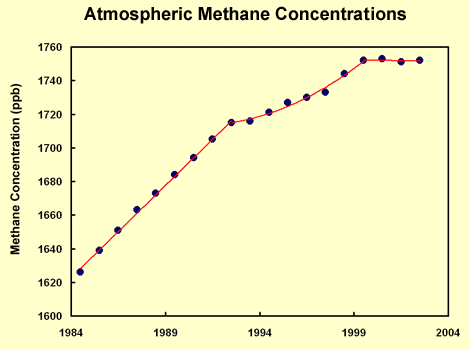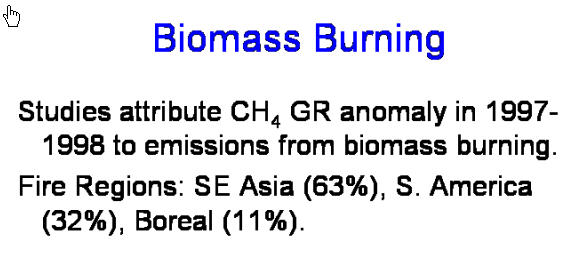
The current concentration of CO2 (carbon dioxide) is 388 ppm. The current concentration of CH4 (methane) is 1.8 ppm or 21x1.8 = 38 ppm CO2 equivalent. This is 10% of CO2.

And it tracks the world population growth pretty well.

But strangely, the atmospheric concentration now seems to be leveling off making it more difficult to know what future methane emissions might be. However, the likely scenario is that these emissions will continue to rise.
Wetlands emission are key here:
After declining in the 1990s due to the industrial collapse of the Soviet Union, and the combination of more efficient use of natural gas and efforts to reduce landfill methane emissions in the West, emissions have risen since 1999 due possibly, in part, to the booming Chinese economy. Had it not been for this reduction in methane emissions from wetlands, atmospheric levels of methane would most likely have continued rising," said Dr Paul Steele, from a scientist from Australia's CSIRO Marine and Atmospheric Research and one of the paper's authors. "This suggests that, if the drying trend is reversed and emissions from wetlands return to normal, atmospheric methane levels may increase again, worsening the problem of climate change."

THIS JUST IN  New satellite measurements indicated the Amazon Rain Forest produces more methane than previously thought.
New satellite measurements indicated the Amazon Rain Forest produces more methane than previously thought.


In the US, the rate of many sources is either slowly shrinking or stabilizing. This may indicate that developed nations can effectively control their methane emission:

But history of development may likely repeat itself for the rest of the world:

Methane Removal Mechanism (some estimates suggest the methane residence time is up to 12 years, so there is no short term equilibrium control):
Atmospheric chemistry (which can be modified by volcanic eruptions like Pinatubo):
 CO2 +
2H20
CO2 +
2H20
This end reaction occurs through the following steps (of interest only to chemists ...)
 H2O + CH3O2
H2O + CH3O2
 H2CO + HO2 + NO2
H2CO + HO2 + NO2
 CH3OOH + O2
CH3OOH + O2
 H2 + CO
H2 + CO
 H2O + CH3O2
H2O + CH3O2



In sum, it is very difficult to predict the future growth of methane retention in the atmosphere, but it's likely to pickup again, especially with more aggressive mining of remaining natural gas reserves and the continued consumption of rice and cows.
There is, however, potentially, a much worse problem. A major concern, a positive feedback loop:

Note, however, that "catastrophic" release of CH4 during period of Ice Ages may be the natural way that the Earth accelerates from a glacial period:

Known hydrate deposits ̶ found typically in continental shelf where marine organisms (microbes) actively feed on carbon and carbon related products to produce methane in the sediments.



Good overview of the hydrate "problem".
And here is a likely scenario that has happened in the geological past:

